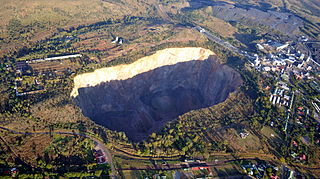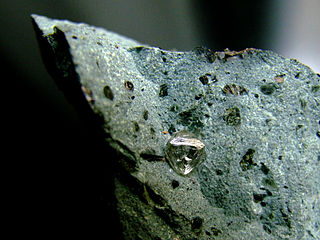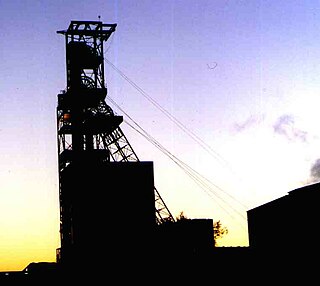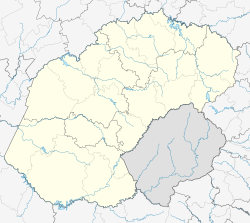
The De Beers Group is a South African-British corporation that specializes in the diamond industry, including mining, exploitation, retail, inscription, grading, trading and industrial diamond manufacturing. The company is active in open-pit, underground, large-scale alluvial and coastal mining. It operates in 35 countries with mining taking place in Botswana, Namibia, South Africa, and Canada. It also has an artisanal mining business, Gemfair, which operates in Sierra Leone.

Koffiefontein is a small farming town in the Free State province of South Africa. The name means coffee fountain in Afrikaans.

The Williamson Diamond Mine is a diamond mine 23 kilometres (14 mi) northeast of Shinyanga in Tanzania; it became well known as the first significant diamond mine outside of South Africa. The kimberlite pipe was found in March 1940 and the mine established by John Williamson, a Canadian geologist, and has been continuous operation since then, making it one of the oldest continuously operating diamond mines in the world. Over its lifetime it has produced over 19 million carats (3,800 kg) of diamonds. A 2020 report by The Guardian said that high-quality pink diamonds from the mine could value up to $700,000 a carat.

The Excelsior Diamond is a gem-quality diamond, and was the largest known diamond in the world from the time of its discovery in 1893 until 1905, when the Cullinan Diamond was found. It was found on June 30, 1893, at the Jagersfontein Mine in South Africa, 130 kilometres south east of Kimberley whose fame as a diamond mining center always overshadowed that of Jagersfontein. It had a blue-white tint and weighed 971 old carats or 995.2 metric carats. The Excelsior rates as the fourth largest rough diamond of gem quality ever found. It was ultimately cut into ten stones weighing from 13 to 68 carats.

The Jubilee Diamond, originally known as the Reitz Diamond is a colourless, cushion-shaped diamond weighing 245.35 carats, making it the sixth largest diamond in the world. It was originally named after Francis William Reitz, the then president of the Orange Free State where the stone was discovered, before being renamed to honour the 60th anniversary of the coronation of Queen Victoria in 1897.

The Premier Mine is an underground diamond mine owned by Petra Diamonds in the town of Cullinan, 40 kilometres (25 mi) east of Pretoria, Gauteng Province, South Africa. Established in 1902, it was renamed the Cullinan Diamond Mine in November 2003 in celebration of its centenary. The mine is a carrot-shaped volcanic pipe and has a surface area of 32 hectares. The mine rose to prominence in 1905, when the Cullinan Diamond – the largest rough diamond of gem quality ever found – was discovered there.
The Venetia Diamond Mine is South Africa's largest producer of diamonds, since 1995. It is situated close to the South African town of Alldays in the Limpopo province and is located within the 360 km2 Venetia Limpopo Nature Reserve.

Concor Holdings (Proprietary) Limited. is a South African construction and mining services company. It is active throughout Southern Africa, involved in civil engineering, buildings, roads and mining projects. Concor returned as an independent brand in late 2016.

The Kimberley Mine or Tim Kuilmine is an open-pit and underground mine in Kimberley, South Africa, and claimed to be the deepest hole excavated by hand, although this claim is disputed by Jagersfontein.

Alrosa is a Russian group of diamond mining companies that specialize in exploration, mining, manufacture, and sale of diamonds. The company leads the world in diamond mining by volume. Mining takes place in Western Yakutia, the Arkhangelsk region, and Africa. Alrosa is Russia's leading diamond mining and distribution company, accounting for 95% of Russian diamond production and 27% of global diamond extraction.

The Finsch Mine is an underground diamond mine in the Northern Cape. Located near Lime Acres, 160 km northwest of Kimberley, it was one of seven operations managed by De Beers Consolidated Mines (DBCM), formed in July 2004. Currently, it is owned by Petra Diamonds Pty Ltd.

Koffiefontein Mine is a diamond mine situated in the Free State province, about 80 km from Kimberley, South Africa. It is one of the many Kimberley mines of which Kimberley mine, de Beers mine, Dutoitspan, Bultfontein and Wesselton are its more famous neighbours.

Jagersfontein Mine was an open-pit mine in South Africa, located close to the town of Jagersfontein and about 110 kilometres south-west of Bloemfontein. Since it was first established, two of the ten biggest diamonds ever discovered, the Excelsior and the Reitz, were mined from Jagersfontein. The term "Jagers" has since been coined to denote the distinctive faint bluish tint of the gems from this mine. Among geologists, Jagersfontein is known as a kimberlite pipe, and a prime locality for mantle xenoliths, some of which are believed to have come from depths of 300–500 km (190–310 mi).

The Mining industry of Ghana accounts for 5% of the country's GDP and minerals make up 37% of total exports. Gold contributes over 90% of the total mineral exports. Thus, the main focus of Ghana's mining and minerals development industry remains focused on gold. Ghana is Africa's largest gold producer, producing 80.5 t in 2008. Ghana is also a major producer of bauxite, manganese and diamonds. Ghana has 20 large-scale mining companies producing gold, diamonds, bauxite and manganese; over 300 registered small scale mining groups; and 90 mine support service companies. Other mineral commodities produced in the country are natural gas, petroleum, salt, and silver.
Mining in Angola is an activity with great economic potential since the country has one of the largest and most diversified mining resources of Africa. Angola is the third largest producer of diamonds in Africa and has only explored 40% of the diamond-rich territory within the country, but has had difficulty in attracting foreign investment because of corruption, human rights violations, and diamond smuggling. Production rose by 30% in 2006 and Endiama, the national diamond company of Angola, expects production to increase by 8% in 2007 to 10,000,000 carats (2,000 kg) annually. The government is trying to attract foreign companies to the provinces of Bié, Malanje and Uíge. Angola has also historically been a major producer of iron ore.

Petra Diamonds Ltd is a diamond mining group headquartered in Jersey. Petra own one of the world's most productive mines historically, the Cullinan Diamond Mine is famed for having produced the world's largest rough and polished diamond. The company is listed on the London Stock Exchange.

Brown diamonds are the most common color variety of natural diamonds. In most mines, brown diamonds account for 15% of production. The brown color makes them less attractive to some people as gemstones, and most are used for industrial purposes. However, improved marketing programs, especially in Australia and the United States, have resulted in brown diamonds becoming valued as gemstones and even referred to as chocolate diamonds.

Francis Oats was a Cornish miner who became chairman of De Beers diamond company. He made extensive investments in the Cornish tin mining industry, which collapsed after he had died. He is known for Porthledden, a mansion he built at the tip of Cornwall.

The Free State Gold Rush was a gold rush in Free State, South Africa. It began after the end of World War II, even though gold had been discovered in the area around the year 1934. It drove major development in the region until the mid–to–late 1980s as part of the mineral revolution in South Africa.
The 2022 Jagersfontein Tailings Dam Collapse was a structural failure of a mine tailings dam near Jagersfontein, located in the Free State province of South Africa, resulting in a mudslide.




















